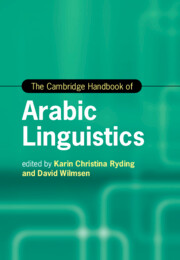Book contents
- The Cambridge Handbook of Arabic Linguistics
- Cambridge Handbooks in Language and Linguistics
- The Cambridge Handbook of Arabic Linguistics
- Copyright page
- Contents
- Figures
- Tables
- Notes on Contributors
- Acknowledgements
- Abbreviations
- Introduction
- Part I Arabic Applied Linguistics
- Part II Arabic Variation and Sociolinguistics
- Part III Theoretical and Descriptive Studies
- Part IV Arabic Computational and Corpus Linguistics
- Part V Arabic Linguistics and New Media Studies
- Part VI Arabic Linguistics in Literature and Translation
- 23 Vernacular Varieties in Recent Arabic Literature
- 24 Stylistics and Translation
- Index
- References
23 - Vernacular Varieties in Recent Arabic Literature
from Part VI - Arabic Linguistics in Literature and Translation
Published online by Cambridge University Press: 23 September 2021
- The Cambridge Handbook of Arabic Linguistics
- Cambridge Handbooks in Language and Linguistics
- The Cambridge Handbook of Arabic Linguistics
- Copyright page
- Contents
- Figures
- Tables
- Notes on Contributors
- Acknowledgements
- Abbreviations
- Introduction
- Part I Arabic Applied Linguistics
- Part II Arabic Variation and Sociolinguistics
- Part III Theoretical and Descriptive Studies
- Part IV Arabic Computational and Corpus Linguistics
- Part V Arabic Linguistics and New Media Studies
- Part VI Arabic Linguistics in Literature and Translation
- 23 Vernacular Varieties in Recent Arabic Literature
- 24 Stylistics and Translation
- Index
- References
Summary
Eva Marie Håland focuses on the field of literary sociolinguistics as she approaches the testy and as yet unsolved problem for Arabic about the nature of language in literary works, raising the issue of complex discourse coherence relations when two (or more) distinct variants are used. The long-held taboo on encoding vernacular Arabic in writing has seen its hold gradually diminish over time, especially during the last half-century, with rapidly accelerating changes in authentic dialogue and first-person narrative. Håland examines the shifting formulas and standards for vernacular writing and orthography, including blending, codeswitching, and hierarchies of registers used for different purposes, such as parodic stylization.
- Type
- Chapter
- Information
- The Cambridge Handbook of Arabic Linguistics , pp. 565 - 582Publisher: Cambridge University PressPrint publication year: 2021

